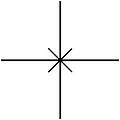Hyeong
Hyeong or hyung is a term used in Korean martial arts to refer to the various forms or patterns practiced by martial artists. These forms are sequences of movements that simulate combat against multiple opponents. Each movement within a hyeong is designed to demonstrate the application of martial arts techniques, including strikes, kicks, blocks, and stances. Hyeong is a fundamental aspect of training in many Korean martial arts, such as Taekwondo, Tang Soo Do, and Hapkido, serving both as a method of practicing techniques and as a way to preserve the martial art's traditions and techniques.
History and Significance[edit]
The concept of hyeong has its roots in ancient Korean martial arts but was further developed and formalized with the modernization of Korean martial arts in the 20th century. In Taekwondo, for example, hyeong are known as "poomsae" and are an essential part of the curriculum, reflecting the art's philosophy, history, and technical evolution. Each hyeong is designed to teach students not only the physical aspects of martial arts but also mental discipline, focus, and the philosophical underpinnings of the art.
Components of Hyeong[edit]
A hyeong consists of a series of individual techniques connected in a fluid sequence. These techniques include:
- Stances (horse stance, front stance, back stance, etc.) that provide the foundation for executing techniques
- Strikes (punches, knife-hands, palm strikes) aimed at various targets on an opponent's body
- Kicks (front kick, side kick, roundhouse kick, etc.) that demonstrate the practitioner's agility and power
- Blocks to defend against imaginary attacks
- Breathing techniques that help in focusing energy and maintaining rhythm throughout the form
Practice and Application[edit]
Practicing hyeong allows martial artists to refine their techniques, improve their physical conditioning, and develop a deeper understanding of the tactical applications of the movements. Mastery of hyeong is often a requirement for advancement in rank within Korean martial arts. Furthermore, hyeong practice is not only a solitary activity but also a competitive one, with practitioners demonstrating their forms in tournaments judged on precision, power, and grace.
Cultural Impact[edit]
Hyung plays a significant role in the cultural aspect of Korean martial arts, serving as a link between the present and the past. Through the practice of hyeong, practitioners connect with the martial traditions of Korea, preserving and perpetuating the cultural heritage of Korean martial arts.
See Also[edit]
-
Taekwondo performance by K-Tigers
-
Trigram for Yang in Korean
-
Hyeong
-
Hyeong
-
Hyeong
-
Hyeong
-
Hyeong
-
Hyeong
-
Hyeong
-
Chon Ji
Ad. Transform your life with W8MD's Budget GLP-1 injections from $75


W8MD offers a medical weight loss program to lose weight in Philadelphia. Our physician-supervised medical weight loss provides:
- Weight loss injections in NYC (generic and brand names):
- Zepbound / Mounjaro, Wegovy / Ozempic, Saxenda
- Most insurances accepted or discounted self-pay rates. We will obtain insurance prior authorizations if needed.
- Generic GLP1 weight loss injections from $75 for the starting dose.
- Also offer prescription weight loss medications including Phentermine, Qsymia, Diethylpropion, Contrave etc.
NYC weight loss doctor appointmentsNYC weight loss doctor appointments
Start your NYC weight loss journey today at our NYC medical weight loss and Philadelphia medical weight loss clinics.
- Call 718-946-5500 to lose weight in NYC or for medical weight loss in Philadelphia 215-676-2334.
- Tags:NYC medical weight loss, Philadelphia lose weight Zepbound NYC, Budget GLP1 weight loss injections, Wegovy Philadelphia, Wegovy NYC, Philadelphia medical weight loss, Brookly weight loss and Wegovy NYC
|
WikiMD's Wellness Encyclopedia |
| Let Food Be Thy Medicine Medicine Thy Food - Hippocrates |
Medical Disclaimer: WikiMD is not a substitute for professional medical advice. The information on WikiMD is provided as an information resource only, may be incorrect, outdated or misleading, and is not to be used or relied on for any diagnostic or treatment purposes. Please consult your health care provider before making any healthcare decisions or for guidance about a specific medical condition. WikiMD expressly disclaims responsibility, and shall have no liability, for any damages, loss, injury, or liability whatsoever suffered as a result of your reliance on the information contained in this site. By visiting this site you agree to the foregoing terms and conditions, which may from time to time be changed or supplemented by WikiMD. If you do not agree to the foregoing terms and conditions, you should not enter or use this site. See full disclaimer.
Credits:Most images are courtesy of Wikimedia commons, and templates, categories Wikipedia, licensed under CC BY SA or similar.
Translate this page: - East Asian
中文,
日本,
한국어,
South Asian
हिन्दी,
தமிழ்,
తెలుగు,
Urdu,
ಕನ್ನಡ,
Southeast Asian
Indonesian,
Vietnamese,
Thai,
မြန်မာဘာသာ,
বাংলা
European
español,
Deutsch,
français,
Greek,
português do Brasil,
polski,
română,
русский,
Nederlands,
norsk,
svenska,
suomi,
Italian
Middle Eastern & African
عربى,
Turkish,
Persian,
Hebrew,
Afrikaans,
isiZulu,
Kiswahili,
Other
Bulgarian,
Hungarian,
Czech,
Swedish,
മലയാളം,
मराठी,
ਪੰਜਾਬੀ,
ગુજરાતી,
Portuguese,
Ukrainian










